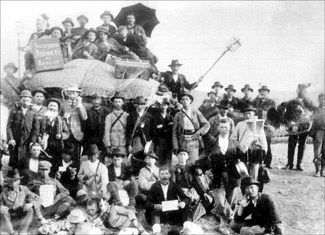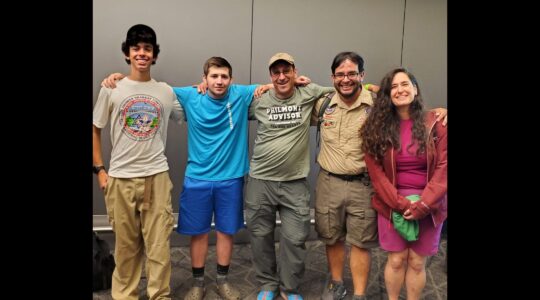TORONTO, Feb. 6 (JTA) — Roughly a century after tens of thousands of impoverished and persecuted Jews walked across Romania in hopes of reaching more hospitable locales abroad, a Canadian writer-photographer has chronicled their story. Jill Culiner’s book follows the footsteps of the largely forgotten “Fusgeyers” — the word is Yiddish for “wayfarers” or “foot-wanderers.” As Culiner recounts in “Finding Home: In the Footsteps of the Jewish Fusgeyers,” she became obsessed with the subject after seeing a mention of the Fusgeyers in Irving Howe’s “World of Our Fathers.” Like much Jewish immigration in history, anti-Semitism prompted the Fusgeyers. When persecution in Romania worsened about 1899, tens of thousands of Jews sold their meager possessions, formed large groups for protection and marched hundreds of miles. Most groups consisted of between 40 and 300 migrants. Representatives of Jewish aid organizations met the weary pedestrians at towns along the Austro-Hungarian border and provided them with food and shelter, as well as train and ship tickets to their ultimate destinations. As many as 70,000 Jews took part in the pedestrian exodus that began in 1900. As Culiner notes, the American Jewish Yearbook of 1903 reported that some 200 to 300 Jews were streaming out of Romania each week, mostly on foot. In 1914, the outbreak of war reduced the flow to a trickle. Culiner found only a few historical works, such as Joseph Kissman’s “The Immigration of Romanian Jews up to 1914,” that dealt with the subject. By far the richest documentary source was Jacob Finkelstein’s “Memoir of a Fusgeyer from Romania to America,” a Yiddish manuscript held by the New York-based YIVO Institute for Jewish Research. A New Yorker who had trekked out of Romania with a pioneering group called the Barlad Fusgeyers, Finkelstein had submitted the work to YIVO in 1942 in response to a contest meant to attract immigrant stories. His first-person narrative took the prize. The Barlad Fusgeyers left the town of Barlad in April 1900 and journeyed some 200 miles in a large semicircle around the base of the Carpathian Mountains. They supported themselves by staging theatrical performances and selling brochures in Jewish towns on their route. It was the director of a Jewish social club, whose members sometimes staged amateur theatrics, who first came up with “a plan about how we can get to America without money,” Finkelstein recorded. “We all grasped the idea. We were a young, strong team with no fear of hardship. The plan had been so simple to work out that we wondered why we hadn’t thought of it before.” Consisting of 75 single men and three women, the Barlad Fusgeyers generated much publicity and public support, and received gifts of food and clothing from both Jews and Romanian peasants along their route. In many places they were welcomed as heroes. Their success encouraged hundreds of other groups to follow. The Fusgeyers’ reception in Central Europe, however, was generally less enthusiastic. For one thing, they were not permitted to continue on foot once they reached the border of the Austro-Hungarian Empire. “In Romania, everyone was proud of them, but by the time they reached Budapest, everyone looked down on them as poor refugees,” Culiner said. “The assimilated Jews of Vienna and Budapest and Germany were especially embarrassed by the Jews from the East. They were afraid they would once again awaken anti-Semitism in the non-Jewish communities.” Culiner, who learned Yiddish in order to read Finkelstein’s story, provides generous translated excerpts in her book; his journey became the template for her own. “Everything that they did, I had to do,” she said. “Where Jacob Finkelstein and the Fusgeyers slept in fields, I had to do the same thing, and that’s what I did. When they were housed by the Jewish community, then I slept in hotels.” A veteran traveler who also speaks German, French, Turkish and “really bad Hungarian,” she traveled with a male companion in search of synagogues, Jewish cemeteries, taverns, teahouses and other settings that Finkelstein had described. Occasionally she succeeded, but often she found few physical relics or traces of a locality’s Jewish past. She located several old synagogues, most in derelict condition. “A strange disconnected place, this synagogue,” she wrote about the former prayer house in Ramnicu Sarat. “It has the air of a long-deserted theatre in which the abandoned stage is set for a forgotten play.” The few remaining Jews she encountered greeted her warmly, she said; many sadly acknowledged that they were part of the closing chapter of Romanian Jewish history. “I asked a man, ‘What’s going to happen to the Jews of Romania?’ and he said, ‘We’re going to die and we’re going be buried in the graveyard and that’ll be the end. There’ll be nobody to replace us.’ ” Numerous museums en route furnished documentary evidence of the Fusgeyers, and more scattered material turned up in larger institutions in Budapest, Vienna, Nuremberg, and London. Particularly rich troves surfaced in Paris and New York. With the help of some thick files found at the Canadian Jewish Congress Archives in Montreal, Culiner concluded her quest by following the Fusgeyer trail to a variety of remote northern Ontario towns and Jewish farming communities in Saskatchewan. Large numbers of Fusgeyers also settled in New York, London, Paris and the towns of Rosh Pina and Zichron Ya’acov in what was then British-mandate Palestine. In addition to “Finding Home,” the Fusgeyer saga may also be gaining new currency from another recent book and perhaps soon from a proposed documentary film as well. Slightly more than a year ago, Florida-based Lighthouse Press published The Wayfarers, a thick historical novel about the Fusgeyers by Los Angeles writer Stuart Tower. The company has optioned documentary film rights to Yale Strom. Meanwhile, Toronto-based Sumach Press will soon extend distribution of “Finding Home” to the United States and Britain, according to Culiner, who recalled that she was perpetually amazed during her journey at how thoroughly the Fusgeyer legend had been erased from popular memory, particularly in Romania. “People just don’t know the story, except for some Romanians of Jewish descent,” she said. “Even the children of Fusgeyers don’t know about it.”
JTA has documented Jewish history in real-time for over a century. Keep our journalism strong by joining us in supporting independent, award-winning reporting.






